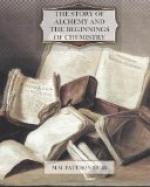Looking back, we cannot think of phlogiston as a substance, or as a thing, in the modern meanings of these terms as they are used in natural science. Nowadays we think, we are obliged to think, of the sum of the quantities of all the things in the universe as unchanging, and unchangeable by any agency whereof we have definite knowledge. The meaning we give to the word thing rests upon the acceptance of this hypothesis. But the terms substance, thing, properties were used very vaguely a couple of centuries ago; and it would be truly absurd to carry back to that time the meanings which we give to these terms to-day, and then to brand as ridiculous the attempts of the men who studied, then, the same problems which we study now, to express the results of their study in generalisations which employed the terms in question, in what seems to us a loose, vague, and inexact manner.
By asserting, and to some extent experimentally proving, the existence of one principle in many apparently very different substances (or, as would be said to-day, one property common to many substances), the phlogistic theory acted as a very useful means for collecting, and placing in a favourable position for closer inspection, many substances which would probably have remained scattered and detached from one another had this theory not been constructed. A single assumption was made, that all combustible substances are alike in one respect, namely, in containing combined fire, or phlogiston; by the help of this assumption, the theory of phlogiston emphasised the fundamental similarity between all processes of combustion. The theory of phlogiston was extraordinarily simple, compared with the alchemical vagaries which preceded it. Hoefer says, in his Histoire de la Chimie, “If it is true that simplicity is the distinctive character of verity, never was a theory so true as that of Stahl.”
The phlogistic theory did more than serve as a means for bringing together many apparently disconnected facts. By concentrating the attention of the students of material changes on one class of events, and giving descriptions of these events without using either of the four alchemical Elements, or the three Principles, Stahl, and those who followed him, did an immense service to the advancement of clear thinking about natural occurrences. The principle of phlogiston was more tangible, and more readily used, than the Salt, Sulphur, and Mercury of the alchemists; and to accustom people to speak of the material substance which remained when a metal, or other combustible substance, was calcined or burnt, as one of the elements of the thing which had been changed, prepared the way for the chemical conception of an element as a definite substance with certain definite properties.
In addition to these advantages, the phlogistic theory was based on experiments, and led to experiments, the results of which proved that the capacity to undergo combustion might be conveyed to an incombustible substance, by causing it to react with some other substance, itself combustible, under definite conditions. The theory thus prepared the way for the representation of a chemical change as an interaction between definite kinds of substances, marked by precise alterations both of properties and composition.




